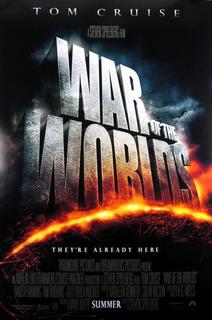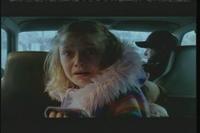'War of the Worlds'

A new benchmark for the alien-invasion genre
Released: June 28, 2005
Official War of the Worlds Site
Sci-Fi Thriller
Starring Tom Cruise, Dakota Fanning, Justin Chatwin, Miranda Otto, Tim Robbins
PG-13 (for violent and disturbing thematic sequences and language)
Running Time: 117 Minutes
by Glenn Johnson




4 Out Of 5 Bites
When I saw a rerun of Byron Haskin and George Pal's 1953 version of War of the Worlds in 1981 (which won an Oscar for special effects), I was an instantly smitten-fourth-grader, incessantly depicting the floating alien craft with its heat rays on all of my school papers. The ability with which War of the Worlds has to draw you into this kind of child-like wonder and awe is what makes the picture work.
With War of the Worlds, Steven Spielberg has effectively hoisted a new standard for what alien-invasion films should be. That is only if its successors can capture the macabre vision of this genre such as he has in this film. The demure-by-comparison cult classic, Close Encounters of the Third Kind, was his initial foray into the alien/UFO theme, albeit the "lemme-shake-your-hand-and-be-your-friend" kind (which was then a novel thing to do with alien invasion films).
War of the Worlds is where Spielberg is unrivaled and in touch with the boyhood fascinations that percolate in his edgier, imaginative movies.....and the film compels you to revel in its sheer spectacle. Spielberg has rekindled/rediscovered his forte and it is simultaneously fun and perturbing.
From the beginning of it all, the 1898 release of H.G. Wells' novel The War of The Worlds was seen as a literary condemnation of European colonialism around the world. Orson Welles' dramatic radio adaptation of the book the day before Halloween in 1938 produced a genuine panic in the war-fearing populace. Haskin and Pal's 1953 theatrical version played in the midst of a blossoming Cold War. Each of these representations occurred in a specific cultural context ripe with anxiety. Given the backdrop and specter of today's terror-weary culture of fear, War of the Worlds advantageously finds its place yet again.
It is known that the film chronicles the family's growth, maturity and unification in light of the alien onslaught. In truth, there is more of the human story to tell than a political statement to make and, in this instance, the former works better than the latter. Fortunately, the political innuendo (where it happens) in the dialogue and story line is overshadowed by the magnitude of the human situation. There are some instances where the story could easily diverge into tiring political blather if it weren't careful.
Tom Cruise plays self-absorbed and cocky dock-worker Ray Ferrier who inherits his preteen girl Rachel (Dakota Fanning) and his angst-ridden teen son, Robbie (Justin Chatwin) for the weekend when his ex, Mary-Anne, (Miranda Otto) and her husband, Tim, embark on a trip. From the outset, the familial tension is heavily strained and protracted to such levels of disrespect flowing from unresolved emotional baggage that the girl Rachel appears to be the anchor of maturity amidst the older brother and father. This might be natural desert or just plain lucky for us given Cruise's detached-from-reality Katie-frolic on Oprah's couch still fresh on our minds. It's finally time to diverge our attention to the movie where it belongs.
As to be expected, Cruise holds his own as the aforementioned New Jersey stevedore. Fanning, as the preternaturally mature and wise child, emerges further into her place as arguably one of the best child actors to come in a while. She exudes an effortless air of natural believability that plays well across her extensive emotive ranges. At once she can be the epitome of a terrorized child in the back seat of a van with a whelp and a teared eye that yearns for your arms of comfort. In the next instant, she can display the settling wisdom and serene calm of a knowing old-soul five times her age, but in a kid-like way. Of the human performers, hers is the most memorable.
 The relationship between the father and son seems concocted at times from the tired places of their mutual misunderstandings, but not more so than the cogent resolution the film offers the two characters later on.
The relationship between the father and son seems concocted at times from the tired places of their mutual misunderstandings, but not more so than the cogent resolution the film offers the two characters later on.We are quickly dispatched into the melee with Morgan Freeman's unmistakeable and cadent opening monologue. The movie moves quickly to the freaky electro-magnetic storm, once having established Cruise as the bumbling dad. From the machine emerging at the intersection, the escape from the city, the plane scene, to the van scene all the way to the ferry, the pace is frenetic and numbing to the marrow. That is, as long as the picture goes with the machines.
However, it suffers and plods a bit when it offers commentary regarding the tendency of human behavior when confronted with its finitude and limitation, partially in the attack on the van and especially in the sidetrack with the maddened and crazed Ogilvy (Tim Robbins). And it isn't so much that the movie doesn't have the right to do so......you're just left wondering more about what those machines are going to do next. Perhaps these vignettes may not be any more informative on human behavior than that to which we are already accustomed (such as greed, fight-or-flight and self-preservation under massive duress) because the human drama that can only occur is either radically tragic or surreal in its human victory. But given that, the success in this part of the telling of the story is that our fragility comes as awfully close to being our own undoing as are any alien activities that could ever close in to finish us.
Let it be said that the main characters are the insecty and mechanical, three-legged nightmares enlivened by Oscar award-winning Dennis Muren and his Industrial Light and Magic (I.L.M.). I expect this War of the Worlds to garner an effects nomination here as well.
The initial appearance sequence of the machine, erect and eclipsing the sun, is as riveting and ghastly a scenario as one could dare imagine and it may have left its inimitably-cratered place in science fiction cinematic history. This scene is one reason why I would finally determine to come and see the film again. Camera angles are layered and revelatory, creative and playful as you would expect from Spielberg. Composer John Williams hones a score that cloaks and adorns the tripods to perfecting and horrific proportions. So portentious are the droning, repetitive and anticipatory tones, trills and movements that you could almost envision an alien conductor orchestrating the musical story alongside the visual if you didn't know better.
It isn't enough that the human characters progress throughout the movie. Concurrent with the earthly family is the story of the development of the tripods. In each of their featured sequences, they appear with progressively varying and dastardly objectives, carrying them out with horrendous purpose. The machines are afforded various indiosyncrasies, traits and physical characteristics as to be actual creatures in and of themselves and not just vehicles for tinier alien drivers. The machines creak, pump and grind as one would expect from other-worldly mechanical processes but they also spew fluids and gases in very "bodily" ways. In the eerie and seminal intersection scene early on, a stunned crowd and a towering two-hundred foot tripod behold one another for the first time in a nervous silence until the tripod finally bellows forth a "greeting" in an ominously deafening two-toned "honk." This honk-progression occurs in a musical minor-third, which cleverly creates the atmosphere from which horrible portents will flow. Spielberg has the music tell the story again, when Tony Bennett's "If I Ruled The World" echoes from the Hudson Ferry between the grotesque train of flames and the triple tripod threat from over the hills to the ferry itself.
Giving the machine such a persona is very deft and very Spielbergian, a la Close Encounters, but with bloody fangs. This attention to fine detail makes the experience of the machines very believable. Overall, the viewer must definitely pay attention to even the most fleeting of details in the auditory and visual imagery because, in classic Speilberg fashion, the story is ongoing in the seemingly mundane.
The telling is Spielberg's own crafting with sprinkled bits of homage to the material of his predecessors. If you are cognizant of this, then the picture's landing may be more palatable and your romp with the film's real stars, more enjoyable.

<< Home